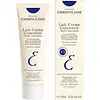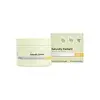What's inside
What's inside
 Key Ingredients
Key Ingredients

No key ingredients
 Benefits
Benefits

 Concerns
Concerns

 Ingredients Side-by-side
Ingredients Side-by-side

Water
Skin ConditioningParaffinum Liquidum
EmollientStearic Acid
CleansingPalmitic Acid
EmollientGlyceryl Stearate Se
EmulsifyingTriethanolamine
BufferingCera Alba
EmollientCetyl Palmitate
EmollientButyrospermum Parkii Butter
Skin Conditioning1,2-Hexanediol
Skin ConditioningCaprylyl Glycol
EmollientSteareth-10
EmulsifyingPolyacrylamide
C13-14 Isoparaffin
EmollientParfum
MaskingLaureth-7
EmulsifyingPropylene Glycol
HumectantTropolone
Skin ConditioningHydrolyzed Soy Protein
HumectantAloe Barbadensis Leaf Extract
EmollientWater, Paraffinum Liquidum, Stearic Acid, Palmitic Acid, Glyceryl Stearate Se, Triethanolamine, Cera Alba, Cetyl Palmitate, Butyrospermum Parkii Butter, 1,2-Hexanediol, Caprylyl Glycol, Steareth-10, Polyacrylamide, C13-14 Isoparaffin, Parfum, Laureth-7, Propylene Glycol, Tropolone, Hydrolyzed Soy Protein, Aloe Barbadensis Leaf Extract
Water
Skin ConditioningGlycerin
HumectantC12-15 Alkyl Benzoate
AntimicrobialEthylhexyl Methoxycinnamate
UV AbsorberButyl Methoxydibenzoylmethane
UV AbsorberGlyceryl Stearate Se
EmulsifyingPolyglyceryl-3 Methylglucose Distearate
EmulsifyingIsohexadecane
EmollientDimethicone
EmollientStearyl Alcohol
EmollientOctyldodecanol
EmollientOctocrylene
UV AbsorberSapindus Mukorossi Fruit Extract
Skin ConditioningCaesalpinia Spinosa Gum
Skin ConditioningBetaine
HumectantNelumbium Speciosum Flower Extract
Skin ConditioningActinidia Chinensis Fruit Extract
EmollientMorus Nigra Leaf Extract
Skin ConditioningButyrospermum Parkii Butter
Skin ConditioningTocopheryl Acetate
AntioxidantLecithin
EmollientTocopherol
AntioxidantAscorbyl Palmitate
AntioxidantCarbomer
Emulsion StabilisingParfum
MaskingXanthan Gum
EmulsifyingStearic Acid
CleansingPhenoxyethanol
PreservativeEthylhexylglycerin
Skin Conditioning2-Bromo-2-Nitropropane-1,3-Diol
PreservativePotassium Sorbate
PreservativeSodium Benzoate
MaskingSodium Hydroxide
BufferingCitric Acid
BufferingCitronellol
PerfumingCoumarin
PerfumingEugenol
PerfumingGeraniol
PerfumingLinalool
PerfumingDisodium EDTA
Water, Glycerin, C12-15 Alkyl Benzoate, Ethylhexyl Methoxycinnamate, Butyl Methoxydibenzoylmethane, Glyceryl Stearate Se, Polyglyceryl-3 Methylglucose Distearate, Isohexadecane, Dimethicone, Stearyl Alcohol, Octyldodecanol, Octocrylene, Sapindus Mukorossi Fruit Extract, Caesalpinia Spinosa Gum, Betaine, Nelumbium Speciosum Flower Extract, Actinidia Chinensis Fruit Extract, Morus Nigra Leaf Extract, Butyrospermum Parkii Butter, Tocopheryl Acetate, Lecithin, Tocopherol, Ascorbyl Palmitate, Carbomer, Parfum, Xanthan Gum, Stearic Acid, Phenoxyethanol, Ethylhexylglycerin, 2-Bromo-2-Nitropropane-1,3-Diol, Potassium Sorbate, Sodium Benzoate, Sodium Hydroxide, Citric Acid, Citronellol, Coumarin, Eugenol, Geraniol, Linalool, Disodium EDTA
 Reviews
Reviews

Ingredients Explained
These ingredients are found in both products.
Ingredients higher up in an ingredient list are typically present in a larger amount.
This ingredient is also known as shea butter. It is an effective skin hydrator and emollient.
Emollients help soothe and soften your skin. It does this by creating a protective film on your skin. This barrier helps trap moisture and keeps your skin hydrated. Emollients may be effective at treating dry or itchy skin.
Shea butter is rich in antioxidants. Antioxidants help fight free-radicals, or molecules that may harm the body. It is also full of fatty acids including stearic acid and linoleic acid. These acids help replenish the skin and keep skin moisturized.
While Shea Butter has an SPF rating of about 3-4, it is not a sunscreen replacement.
Shea butter may not be fungal acne safe. We recommend speaking with a professional if you have any concerns.
Learn more about Butyrospermum Parkii ButterGlyceryl Stearate Se is a self-emulsifying (SE) form of glyceryl stearate. Self-emusifying means this ingredient automatically blends with water. It is an emulsifier, emollient, and cleansing agent.
As an emulsifier, Glyceryl Stearate Se prevents ingredients such as oil and water from separating. It is also a surfactant, meaning it helps cleanse the skin. Surfactants help gather oil, dirt, and other pollutants so they may be rinsed away easily.
Emollients help your skin stay smooth and soft. It does so by creating a film on top of the skin that helps trap moisture in.
Learn more about Glyceryl Stearate SeParfum is a catch-all term for an ingredient or more that is used to give a scent to products.
Also called "fragrance", this ingredient can be a blend of hundreds of chemicals or plant oils. This means every product with "fragrance" or "parfum" in the ingredients list is a different mixture.
For instance, Habanolide is a proprietary trade name for a specific aroma chemical. When used as a fragrance ingredient in cosmetics, most aroma chemicals fall under the broad labeling category of “FRAGRANCE” or “PARFUM” according to EU and US regulations.
The term 'parfum' or 'fragrance' is not regulated in many countries. In many cases, it is up to the brand to define this term.
For instance, many brands choose to label themselves as "fragrance-free" because they are not using synthetic fragrances. However, their products may still contain ingredients such as essential oils that are considered a fragrance by INCI standards.
One example is Calendula flower extract. Calendula is an essential oil that still imparts a scent or 'fragrance'.
Depending on the blend, the ingredients in the mixture can cause allergies and sensitivities on the skin. Some ingredients that are known EU allergens include linalool and citronellol.
Parfum can also be used to mask or cover an unpleasant scent.
The bottom line is: not all fragrances/parfum/ingredients are created equally. If you are worried about fragrances, we recommend taking a closer look at an ingredient. And of course, we always recommend speaking with a professional.
Learn more about ParfumStearic Acid is a fatty acid. It is an emollient, emulsifier, and texture enhancer.
As an emollient, stearic acid helps soften skin. It aids the skin's protective barrier by preventing water loss. It also provides a gentle cleansing effect without stripping away natural oils.
Stearic acid may also be used to enhance the texture of products. It can add volume and stabilize ingredients such as water and oil. This can help water and oil ingredients from separating.
Sources of stearic acid include animal or vegetable fats/oils such as coconut or shea. It can be naturally found in butter, cocoa butter, shea butter, vegetable fats, and animal tallow.
This ingredient may not be Malassezia folliculitis, or fungal-acne safe.
Learn more about Stearic AcidWater. It's the most common cosmetic ingredient of all. You'll usually see it at the top of ingredient lists, meaning that it makes up the largest part of the product.
So why is it so popular? Water most often acts as a solvent - this means that it helps dissolve other ingredients into the formulation.
You'll also recognize water as that liquid we all need to stay alive. If you see this, drink a glass of water. Stay hydrated!
Learn more about Water